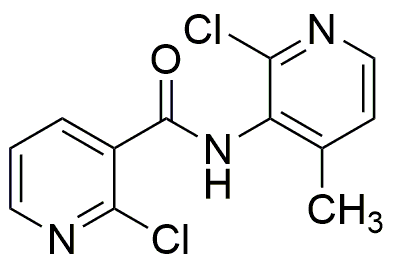2-Chloro-N-(2-chloro-4-methyl-3-pyridyl)nicotinamide is widely utilized in research focused on:
- Pharmaceutical Development: This compound serves as a key intermediate in the synthesis of various pharmaceuticals, particularly those targeting specific diseases, enhancing drug efficacy and specificity.
- Agricultural Chemistry: It is employed in the formulation of agrochemicals, providing effective solutions for pest control while minimizing environmental impact, making it valuable for sustainable agriculture.
- Biochemical Research: Researchers use it to study enzyme inhibition and receptor interactions, contributing to the understanding of biological pathways and disease mechanisms.
- Material Science: The compound is explored for its potential in developing new materials, particularly in coatings and polymers, due to its unique chemical properties.
- Analytical Chemistry: It is utilized as a standard in analytical methods, aiding in the accurate detection and quantification of related compounds in various samples.
General Information
Properties
Safety and Regulations
Applications
2-Chloro-N-(2-chloro-4-methyl-3-pyridyl)nicotinamide is widely utilized in research focused on:
- Pharmaceutical Development: This compound serves as a key intermediate in the synthesis of various pharmaceuticals, particularly those targeting specific diseases, enhancing drug efficacy and specificity.
- Agricultural Chemistry: It is employed in the formulation of agrochemicals, providing effective solutions for pest control while minimizing environmental impact, making it valuable for sustainable agriculture.
- Biochemical Research: Researchers use it to study enzyme inhibition and receptor interactions, contributing to the understanding of biological pathways and disease mechanisms.
- Material Science: The compound is explored for its potential in developing new materials, particularly in coatings and polymers, due to its unique chemical properties.
- Analytical Chemistry: It is utilized as a standard in analytical methods, aiding in the accurate detection and quantification of related compounds in various samples.
Documents
Safety Data Sheets (SDS)
The SDS provides comprehensive safety information on handling, storage, and disposal of the product.
Product Specification (PS)
The PS provides a comprehensive breakdown of the product’s properties, including chemical composition, physical state, purity, and storage requirements. It also details acceptable quality ranges and the product's intended applications.
Certificates of Analysis (COA)
Search for Certificates of Analysis (COA) by entering the products Lot Number. Lot and Batch Numbers can be found on a product’s label following the words ‘Lot’ or ‘Batch’.
*Catalog Number
*Lot Number
Certificates Of Origin (COO)
This COO confirms the country where the product was manufactured, and also details the materials and components used in it and whether it is derived from natural, synthetic, or other specific sources. This certificate may be required for customs, trade, and regulatory compliance.
*Catalog Number
*Lot Number
Safety Data Sheets (SDS)
The SDS provides comprehensive safety information on handling, storage, and disposal of the product.
DownloadProduct Specification (PS)
The PS provides a comprehensive breakdown of the product’s properties, including chemical composition, physical state, purity, and storage requirements. It also details acceptable quality ranges and the product's intended applications.
DownloadCertificates of Analysis (COA)
Search for Certificates of Analysis (COA) by entering the products Lot Number. Lot and Batch Numbers can be found on a product’s label following the words ‘Lot’ or ‘Batch’.
*Catalog Number
*Lot Number
Certificates Of Origin (COO)
This COO confirms the country where the product was manufactured, and also details the materials and components used in it and whether it is derived from natural, synthetic, or other specific sources. This certificate may be required for customs, trade, and regulatory compliance.


